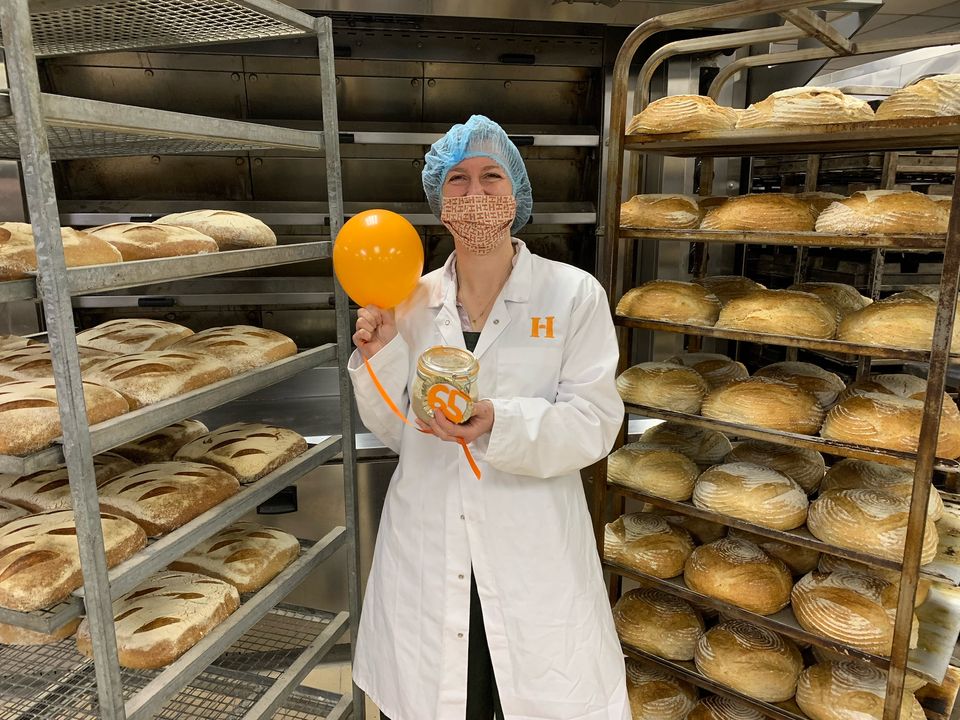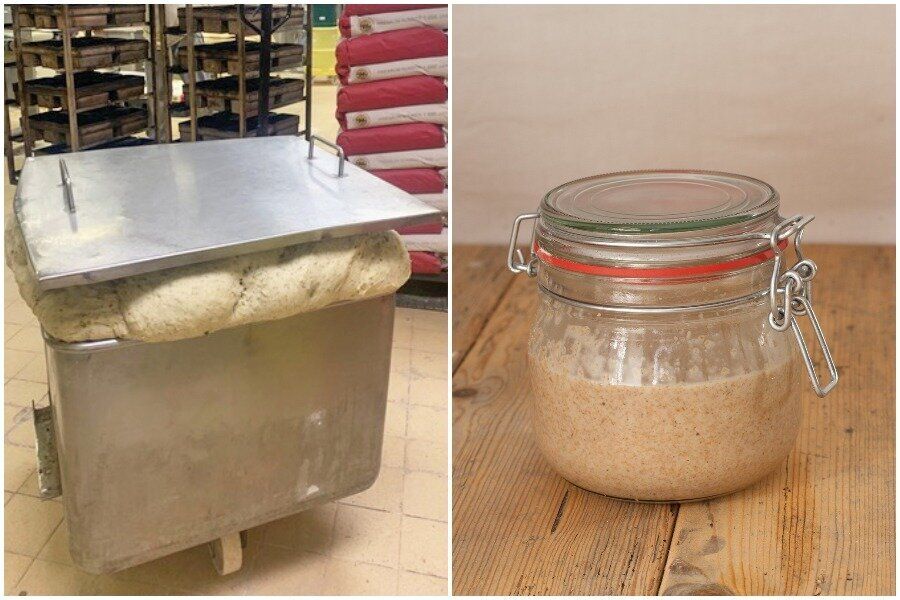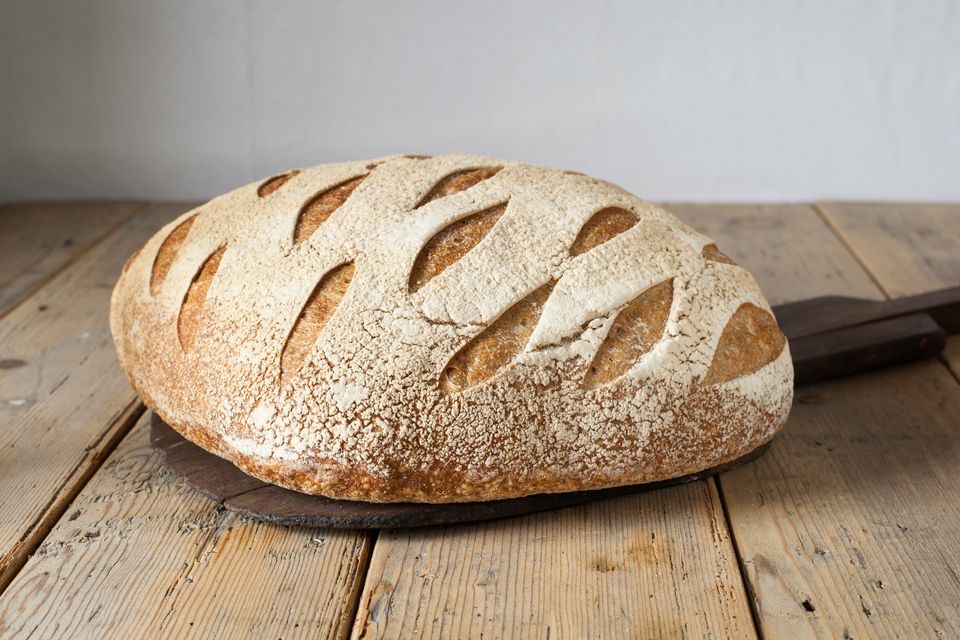
A 65-year-old beast is growing ever fatter in the back of Hobbs House Bakery.
The decades-old sourdough starter – affectionately nicknamed ‘The Monster’ – has been passed down through generations of bakers in the Cotswolds, who diligently feed it water and flour every day.
It’s long outgrown its original Kilner jar – The Monster now resides in two giant vats, with its bubbling belly swelling over the sides.
“It’s not a delicious smell, like fresh bread baking. I’d say it’s more of a… err… an interesting smell,” laughs Anna Herbert, who runs the family business alongside her brother-in-laws, uncle and father-in-law. “It’s kind of intense and tangy!”
The Herbert family have been baking bread for 100 years and have shops in the Cotswolds and Bristol. But like all good fables, there’s a few variations to The Monster’s origin story.

In one version of the story, Grandpa Herbert was given the starter culture during a trip to Germany by a baker who said it was at least 30 years old at the time. That was in 1985.
In another version of the tale, a baker who had retired to the local town of Tetbury gifted the family his yeasty concoction. This baker – also German – is said to have brought it over from Germany after the Second World war.
Either way, the family acquired the starter 35 years ago and believe it was at least 30 years old at the time – possibly, much older. They’ve cared for it since, like a much-loved family pet, even throwing The Monster its own party for its 60th and 65th birthday.
It means the bakery is among the best in the biz, when it comes to having a really old, consistently used live starter. But they haven’t got the crown for Britain’s oldest starter – no one officially has, with starter stories being so hard to validate. Still, there are plenty of bakers who’d like to consider themselves contenders.
Who has Britain’s oldest sourdough starter?
The jury is out on who has Britain’s oldest sourdough – there are even forums where people throw their hat in the ring.
In one of these forums, a UK resident claims their starter dates back to 1857. They were given their starter by an American friend, who got it from her college roommate, who got it from another friend, who got it from his grandmother, who said the dough had been in the family since then.
Another baker, Vanessa Kimbell of Northamptonshire, is convinced her starter is over 100 years old. She can’t pinpoint the exact date, but the dough comes from a bakery in the south of France, where Kimbell grew up before she moved to the UK. The French bakery dates back over 150 years and the older women in the village believe the same starter was used during two World Wars.
Further afield, Canadian Ione Christensen believes she can accurately trace her starter back 120 years. It was passed down from her great-grandfather, which may mean she has the world’s oldest (and most traceable) functioning starter.
But these lively yeast contenders are no match for ‘dormant’ sourdough cultures, that are stored and later revitalised. Franco Manca in Belize Park, London, claims to make their pizza from an 18th century Italian sourdough starter.
Meanwhile the world’s only Sourdough Library, in Belgium, hosts dozens of dubiously dated but undoubtably ancient yeast cultures. Scientists have even revived yeast microbes believed to be stored from 4,500 years ago, to make a loaf of sourdough.
The Herbert’s starter isn’t the oldest – “but it is the nicest!”, hollers Anna’s father-in-law, Trev from the background of our call. Keeping a starter alive for so long is surprisingly easy, she adds.
“It’s not an industry secret. We feed it dark rye flour, because we find it makes the most robust and reliable sourdough,” she explains. “In terms of feeding it, you give it equal parts flour and water. Obviously the quantities really depend on how much you’ve got!”
The Monster is kept in a temperature-controlled space, but the feeding is all done by hand, as tradition dictates. The family recommend following the same method at home, popping your dough in the fridge for a slow rise and the best texture. Invest in a dutch oven if you find your bread collapsing when you turn it out, but above all, keep it simple.

“There are so many different methods online and I think people overcomplicate what they’re doing,” says Anna. “Don’t add too many elements in and change stuff too quickly, too soon.”
For those hoping to replicate the bakery’s bread at home, Hobbs House sells small Kilner jars of sourdough starter, scooped off The Monster itself. They encourage all buyers to name their starter babies – homages to the local bakery, including ‘Herby’ or ‘Hobbs’, seem popular.
Baking the bread yourself may take a little trial and error, but Anna insists it’s worth it. The Herbert family serve a loaf of their own, warm bread with (almost) every meal – “obviously with loads of butter”.
Anna can’t remember the last time she ate packaged, sliced white from the supermarket – or as she calls it, “nasty” bread. For her, it’s akin to asking a Michelin star chef to dine out on McDonalds.
“I just don’t get it,” she says. “I think it’s a bit like what people are starting to say about meat – it’s much better to eat less really good bread than just eating huge batches of bad bread. And actually, you can bake it so much cheaper than you can buy a nasty white loaf.
“If you’ve got the time to learn the skill, now’s the time to do it.”




